

Cooking. Smoked Salmon no Wasabi Fumi Furikake - Eat-Japan Recipes. Matcha Nama Choco Truffle - Eat-Japan Recipes. Recipes - Decorative Food Carving - Eggplant. Reprinted with permission from the book: The Decorative Art of Japanese Food Carving: Elegant Garnishes for All Occasions by Hiroshi Nagashima Kodansha International Japanese cuisine is renowned for the beauty of its presentation.

Among the key elements in this presentation style are mukimono -- the decorative garnishes and carvings that add the final flourish to a dish. In The Decorative Art of Japanese Food Carving, internationally acclaimed chef Hiroshi Nagashima offers 60 edible garnishes and food carvings for home, party or professional use. Recipes - Okinawan Sweet Fritters. Japanese Cuisines. Recipes - Miso soup. Recipes - Japanese cooking basics. Recipes - Yaki-udon (Japanese Seafood Noodle Stir-fry) Recipes - Ochazuke with Salmon Flakes. Reprinted with permission from the book: New Tastes in Green Tea by Mutsuko Tokunaga Kodansha International New Tastes in Green Tea is an original cookbook that ushers an underappreciated flavor into the kitchen as a beverage and a cooking ingredient.

The range of recipes is startling. Whether you are looking for a bevy of palate-pleasing drinks or savory new food recipes, New Tastes in Green Tea is a must-have for anyone seeking to appreciate the versatility and elegant flavorings of one of the world's most healthful beverages. Recipes - Grilled rice balls with vegetable miso.
Reprinted with permission from the book: Izakaya: The Japanese Pub Cookbook by Mark Robinson Kodansha International Japanese pubs, called izakaya, are attracting growing attention in Japan and overseas.

As a matter of fact, a recent article in The New York Times claimed that the izakaya is starting to shove the sushi bar off its pedestal. Eight Tokyo pubs are introduced, ranging from those that serve the traditional Japanese comfort foods such as yakitori (barbequed chicken), to those offering highly innovative creations. For the home chef, the hungry gourmet, the food professional, this is more than a cookbook. Recipes - Shiso Tofu. Reprinted with permission from the book: The Breakaway Japanese Kitchen by Eric Gower Kodansha International The Breakaway Japanese Kitchen is a coup d'etat.
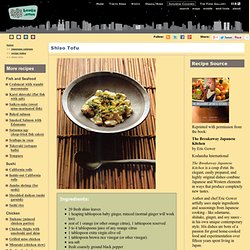
Its elegant, easily prepared, and highly original dishes combine Japanese and Western elements in ways that produce completely new tastes. Author and chef Eric Gower artfully uses staple ingredients and seasonings from Japanese cooking - like edamame, shiitake, ginger, and soy sauce - in his own unique contemporary style. Each recipe expresses Gower's innovative approach: effortless blending of Japanese cuisine with that of other countries (particularly Italy), minimalist presentation, emphasis on time saving, and a playful, free, and joyous approach to the making of great food.
Recipes - Deep-fried Yuba Rolls. Recipes - Achara-zuke (pickles) Achara-zuke pickles are summer pickles, mainly pickled during the O-Bon holidays.
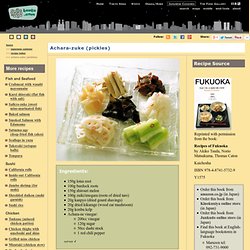
The name comes from the Portuguese word "achar" for pickles. Some people use carrots or hanafu, a flower-shaped wheat gluten cake. Odd numbers are considered lucky in Japan, so seven types of pickles are presented here. Directions 1. 2. Recipes - Seaweed and Potato Patties. Recipes - Green Beans in Sesame Dressing (Ingen no goma-ae) Reprinted with permission from the book: Japanese Cooking for Two by Kurumi Hayter Periplus Editions (HK) Ltd.
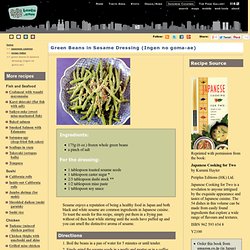
Japanese Cooking for Two is a revelation to anyone intrigued by the exquisite appearance and tastes of Japanese cuisine. The 54 dishes in this volume can be made from easily found ingredients that explore a wide range of flavours and textures. Recipes - Eggplant Salad with Lemon-flavored Plum Dressing. Recipes - Sushi Rice. Recipes - Shredded Daikon. Recipes - Jumbo shrimp for nigiri-zushi.
1.
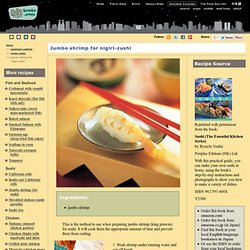
Wash shrimp under running water and cut off heads. Insert a bamboo skewer or long toothpick along shrimp from head to tail, running along legs of shrimp without touching flesh. Drop shrimp into a pot of salted, boiling water (use enough salt to make it taste like seawater). Boiling shrimp in salted water keeps protein in shrimp. They will sink to bottom and after 3 to 5 minutes will change color and rise to top. To check that they are cooked, remove one shrimp from water and squeeze gently. Quickly place shrimp in ice water. To remove skewer, use a screwing motion to avoid breaking flesh. Remove shell from around body, but not tail. Recipes - Inside-out California rolls. Recipes - California Rolls.
Recipes - Saikyo-zuke (sweet miso-marinated fish) Reprinted with permission from the book: Izakaya: The Japanese Pub Cookbook by Mark Robinson Kodansha International Japanese pubs, called izakaya, are attracting growing attention in Japan and overseas.

As a matter of fact, a recent article in The New York Times claimed that the izakaya is starting to shove the sushi bar off its pedestal. Eight Tokyo pubs are introduced, ranging from those that serve the traditional Japanese comfort foods such as yakitori (barbequed chicken), to those offering highly innovative creations. For the home chef, the hungry gourmet, the food professional, this is more than a cookbook. Recipes - Aromatic Baked Salmon. Recipes - Satsuma-age (deep-fried fish cakes) Directions 1.
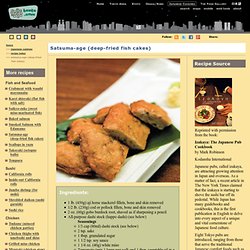
On a paper-lined sheet pan, lightly salt the mackerel fillets, cover with plastic wrap and refrigerate for 2 hours. 2. In a food processor, pulse and grind the fillets into a coarse paste. Transfer into a bowl and set aside. 3. 4. 5. Recipes - Tempura. The classic "batter-fried" food in Japan is tempura, which is no stranger to the West.

What is not well known about this so-called typical Japanese dish is that in actual fact it was introduced, or at least devised, centuries ago by Europeans living in Japan - the Spanish and Portuguese who established missions in southern Japan in the late sixteenth century. The dish caught on with the Japanese, who added the thin, delicately seasoned dipping sauce with grated daikon mixed in.
By now tempura has passed so thoroughly into native cooking that its origin is almost forgotten. While tempura remains an exclusive domain of tempura specialty restaurants, it is also easy enough to make at home with very good results. In its higher forms it is a food reserved for special occasions, in its more pedestrian forms, simply a good meal.
With tempura, the goal is to achieve a lacy, golden effect with the deep-fried coating, not a thick, armorlike pancake casing.